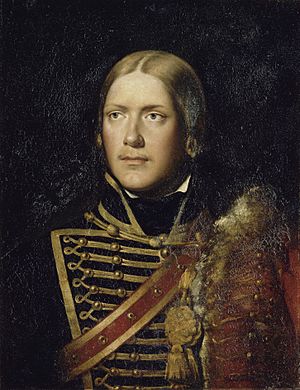Michel Ney facts for kids
Quick facts for kids
Marshal of the Empire
Michel Ney
|
|
|---|---|
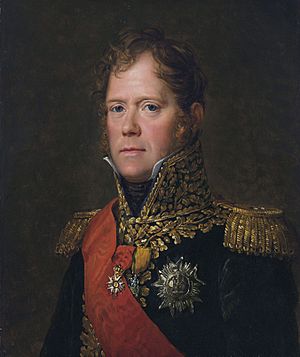
Portrait by François Gérard, 1805
|
|
| Nickname(s) |
|
| Born | 10 January 1769 Sarrelouis, France |
| Died | 7 December 1815 (aged 46) Paris, France |
| Buried |
Père Lachaise Cemetery
|
| Allegiance |
|
| Branch | French Army |
| Service years | 1787–1815 |
| Commands held |
|
| Wars | |
| Awards |
|
| Signature | |
Michel Ney (born January 10, 1769 – died December 7, 1815) was a famous French military leader. He became a Marshal of the Empire under Napoleon I. He fought bravely in many major conflicts, including the French Revolutionary Wars and the Napoleonic Wars.
Napoleon himself called Ney "the Bravest of the Brave." His soldiers also gave him the nickname "Le Rougeaud," which means "the Red-faced one," probably because of his fiery personality.
Contents
Early Life and Beginnings
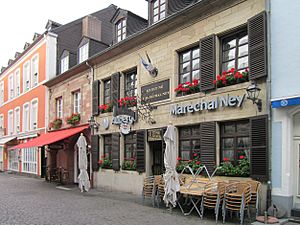
Michel Ney was born in a town called Sarrelouis, in France. This town was close to the German border. Because of this, Ney grew up speaking both French and German.
His father was a cooper, someone who makes barrels. Michel went to school until he was about 13. After that, he worked in an office and then in mines. However, he soon realized that this kind of work was not for him.
Joining the Army
Becoming a Soldier
In 1787, at the age of 18, Ney decided to join the army. Back then, it was hard for ordinary people to become officers. But Ney was very good at his job. He quickly moved up through the ranks as a non-commissioned officer.
After the French Revolution, the army changed. Ney continued to serve and became an officer in 1792. He fought in many battles, like the Battle of Valmy and the Battle of Neerwinden. He was even wounded during the Siege of Mainz.
Rising Through the Ranks
Ney became a brigadier general in 1796. He led cavalry units on the German battlefronts. In 1797, he was captured by Austrian forces but was later exchanged for an Austrian general.
By 1799, Ney was promoted to géneral de division, a very high rank. He commanded cavalry in important campaigns in Switzerland and along the Danube River. He was wounded again at the Battle of Winterthur. After recovering, he fought at the Battle of Hohenlinden in 1800.
Napoleonic Wars and Great Victories
A Marshal of the Empire
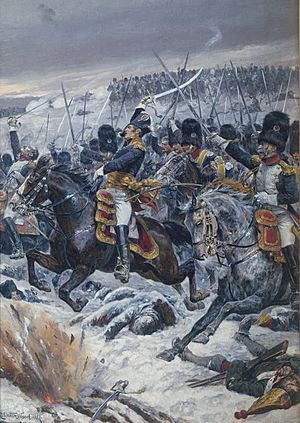
In 1804, Napoleon made Ney one of his first 18 Marshals of the Empire. This was a huge honor. As a Marshal, Ney led the VI Corps of the French army. He was highly praised for his actions at the Battle of Elchingen in 1805. He also captured Innsbruck in Tyrol.
Ney continued to show his bravery in many battles. He fought at Battle of Jena–Auerstedt and helped capture Magdeburg. In 1807, he arrived with his troops just in time to help Napoleon avoid defeat at the Battle of Eylau. He also played a key role at the Battle of Friedland.
Campaigns in Spain and Portugal
In 1808, Ney was given the title of Duke of Elchingen. He was sent to Spain, where he fought in several smaller battles. In 1810, he joined Marshal André Masséna in invading Portugal. He successfully captured two important towns, Ciudad Rodrigo and Almeida.
During the French retreat from Portugal, Ney was in charge of the rearguard. This meant he protected the main army from the enemy. He fought a series of battles, slowing down the British forces. This allowed the French army to retreat safely. However, he was later removed from his command because of disagreements.
The Russian Campaign and Beyond
The Bravest of the Brave
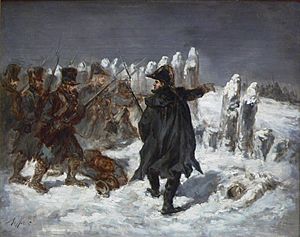
In 1812, Ney commanded the III Corps during Napoleon's invasion of Russia. He was wounded at the Battle of Smolensk and later fought at Battle of Borodino. During the terrible retreat from Moscow, Ney was again in charge of the rearguard. He was known as "the last Frenchman on Russian soil."
At one point, Ney's troops were cut off from the main army. But he managed to escape through a thick fog and rejoin Napoleon. For this incredible act of bravery, Napoleon gave him the famous nickname "the bravest of the brave." Ney also fought at the Battle of Berezina and helped hold a vital bridge at Kovno (now Kaunas). Legend says he was the very last French soldier to cross the bridge out of Russia.
The End of Napoleon's Reign
In 1813, Ney was given the title of Prince of the Moskva. He continued to fight bravely in many battles, including Battle of Lützen and Battle of Leipzig, where he was wounded again.
By 1814, Napoleon's empire was crumbling. At Fontainebleau, Ney was a key figure among the marshals who told Napoleon he had to give up his power. Ney made it clear that the army would no longer follow Napoleon into battle against Paris.
When the old French monarchy was restored, King Louis XVIII honored Ney. He was made a Peer of France. However, some members of the royal court looked down on Ney because he was not born into a noble family.
The Hundred Days and Waterloo
A Difficult Choice
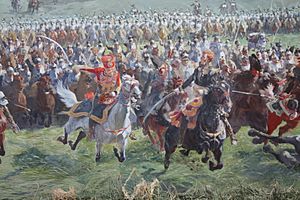
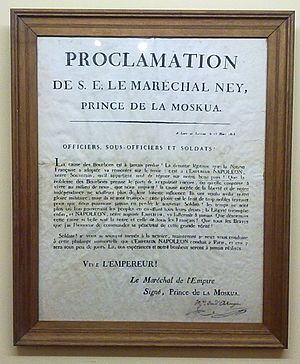
In 1815, Napoleon escaped from exile and returned to France. Ney promised King Louis XVIII that he would stop Napoleon and even bring him back "in an iron cage." However, Napoleon sent Ney a personal letter. This letter reminded Ney of their past victories together.
Despite his promise to the king, Ney decided to join Napoleon on March 18, 1815. This was a very difficult decision for him.
The Battle of Waterloo
Ney was given command of the left side of Napoleon's army during the Hundred Days campaign. On June 16, 1815, he fought against the Duke of Wellington at the Battle of Quatre Bras. Meanwhile, Napoleon fought the Prussians at Battle of Ligny.
Two days later, on June 18, 1815, Ney commanded the left wing at the famous Battle of Waterloo. Around 3:30 p.m., Ney ordered a huge cavalry charge against the British and Allied lines. His cavalry rode over the enemy cannons. But the enemy infantry formed strong square shapes that the cavalry could not break. Ney's charge failed because he didn't have infantry or artillery support.
During the battle, five horses were shot from under Ney. At the end of the day, he led one of the last infantry charges. He shouted to his men, "Come and see how a marshal of France meets his death!" Many people said it seemed like Ney was trying to find death on the battlefield, but it wouldn't take him.
Later Life and Legacy
A Sad End
After Napoleon's final defeat in 1815, Ney was arrested. He was put on trial for turning against the king. His lawyer tried to argue that Ney was no longer French because his hometown had become part of Prussia. But Ney bravely interrupted him, saying, "I am French and I will remain French!"
On December 6, 1815, Ney was found guilty. The next day, he was sadly put to death by a firing squad in Paris. His death caused a lot of disagreement among the French people. He was buried in Père Lachaise Cemetery in Paris.
A Lingering Mystery
Some stories claim that Michel Ney did not actually die. Records in Charleston, South Carolina, show that a man named "Peter Stewart Ney" arrived there the year after Ney's execution. This "Peter Ney" worked as a school teacher in North Carolina until he died in 1846. His last words were supposedly, "I am Ney of France."
His body was dug up twice, but no clear proof was found. However, most historians agree that Michel Ney's execution is well-documented and confirmed.
Family Life
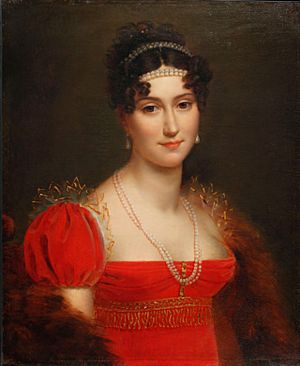
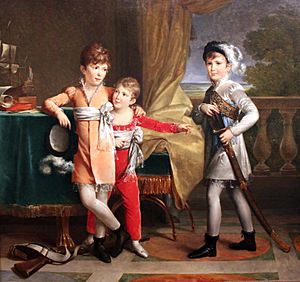
Michel Ney married Aglaé Louise in 1802. They had four sons together:
- Joseph Napoléon
- Michel Louis Félix
- Eugène Michel
- Edgar Napoléon Henry
His sons carried on his titles, like Prince of the Moskva and Duke of Elchingen.
Ney in Books and Movies
Michel Ney's life has inspired many writers and filmmakers.
- He appears briefly in Stendhal's novel The Charterhouse of Parma.
- He is a character in Leo Tolstoy's famous novel War and Peace.
- Victor Hugo praised Ney's bravery in his novel Les Misérables.
- Ney has been played by actors like Dan O'Herlihy in the 1970 film Waterloo.
- He also appeared in the 1972 British TV series War and Peace.
See also
 In Spanish: Michel Ney para niños
In Spanish: Michel Ney para niños
- HMS Marshal Ney, a British warship named after Ney


